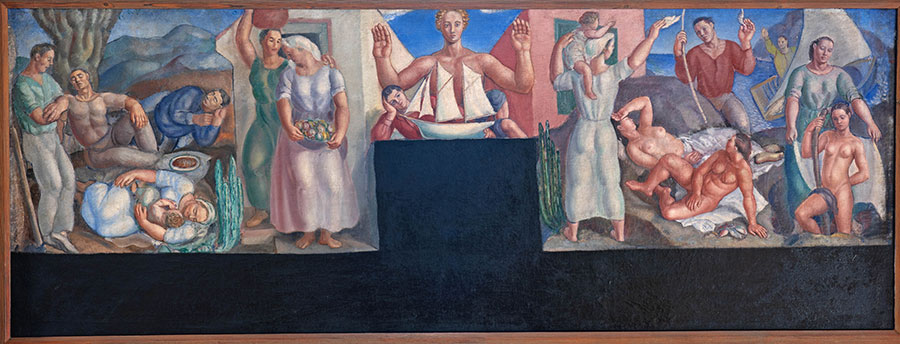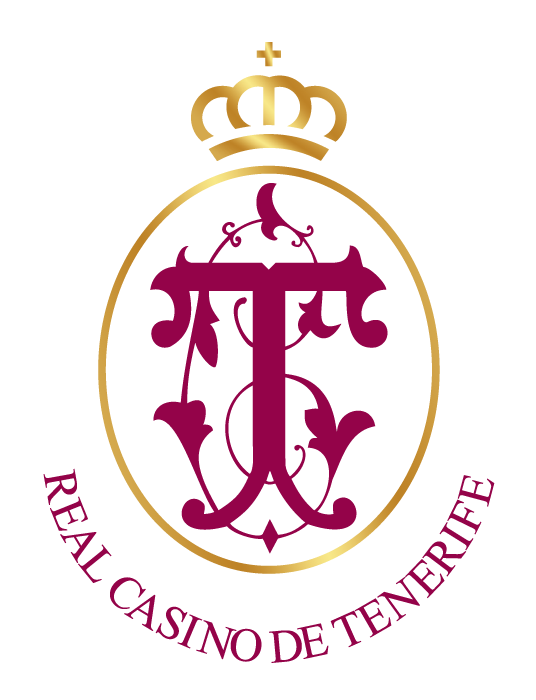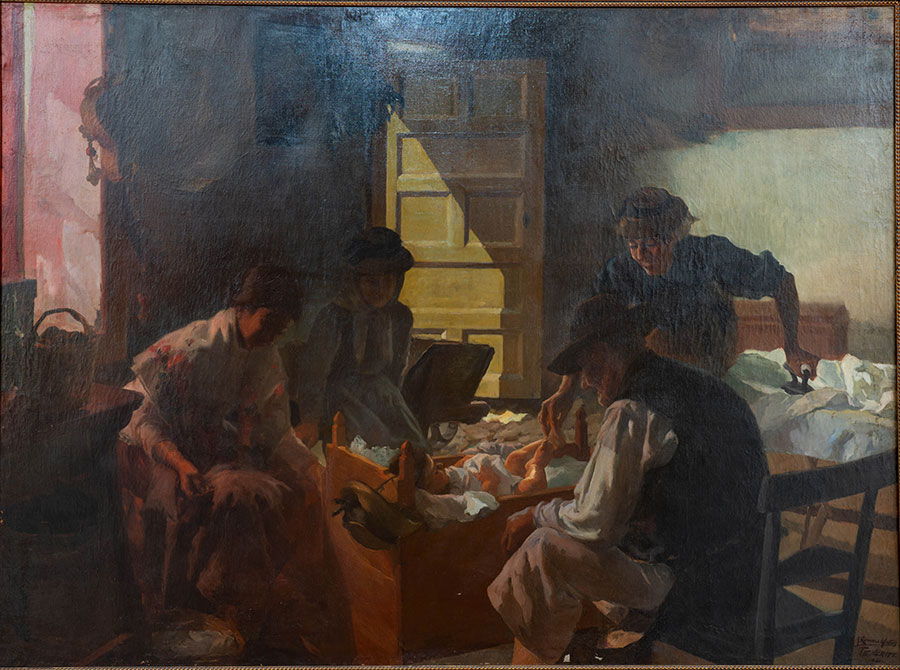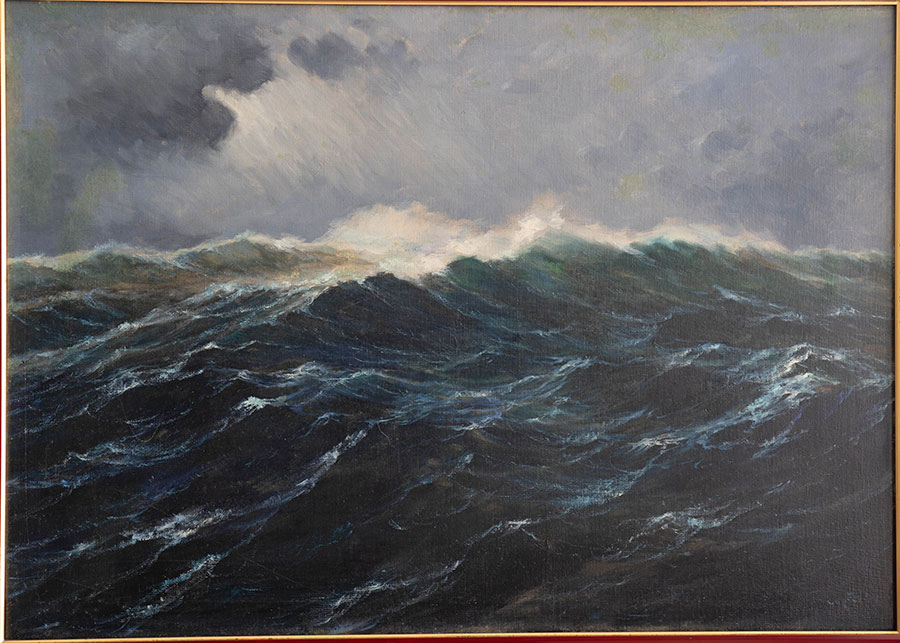
- Type of work: Easel painting
- Technique: Mixed on canvas
- Approximate dimensions: 75 x 200 cm
- Theme: Allegorical
- Title: “Sketch” of the Island Frieze
- Author: José Aguiar García (1895-1976)
- Chronology or Year: 1933
- Historical-artistic analysis:
Style: Regionalist painting, in search of the expression of the Canarian identity (racial painting).
Description: Following the indications given by the then president of the Casino, Mr. Faustino Martín Albertos, the sketch depicts a Canarian theme: the two pillars of the economy of the islands in a balanced composition, where the peasant scene on the left forms a whole with the seafaring scene on the right through the central nexus of the adolescent, contemplating the sailing ship under the protection of a deity. The monumental figures build a space suffocated by their presence, which surrounds and isolates them despite being located outdoors, surrounded by the sea, the geographical environment that shapes the island’s character. On the left, a maternity in the foreground gives way to the rest, under the shade of a dragon tree, of the peasants represented with muscular bodies full of strength, a characteristic also shared by the women of rotund forms, with large and worked feet and hands, carrying the fruits of their harvest. The characters on the right are similarly constituted, and depict the allegory of the sea as a means of work in the woman dismissing the fisherman. The female nudes stand out with full sculptural forms resting on the rocks, in a self-absorbed attitude, out of context. He paints the people but immersed in a contemplative and immobile world, passive before his design.
Date of receipt: Only in March 1943 did the Casino have the sketch in its possession, despite the fact that a photograph of it was included in the signing of the contract, dated December 1933.
Remarks: When it was time to transfer it to the final canvas, the artist modified the scene on the left, undressing the child frolicking in the mother’s arms, eliminating the protective gesture between the two women on the right and replacing the farmer with the hoe with the one proudly carrying the bunch of bananas. The woman with both feet corresponding to the left side in the scene on the right is striking. The work was loaned for the exhibition Ventana al Arte, organized by the Cabildo Insular de Tenerife and curated by Luis Ortega Abraham, which was held at the Auditorio de Tenerife from 15-3-2007 to 13-4-2007. For insurance purposes the work was valued at 6,000 euros.
About the author: José Aguiar García (Vueltas de Santa Clara, Cuba,1895- Madrid, 1976), born in Cuba into a family of emigrants, soon returned to La Gomera where he was baptized in the parish of San Marcos de Agulo. He went to Madrid in 1914 to study Law, but abandoned his studies to study Fine Arts at the School of Fine Arts of San Fernando as a disciple of José Pinazo Martínez (1879 – 1938), continuing his training in Florence with a scholarship from the Cabildo Insular de La Gomera. In contact with Renaissance art (especially Masaccio and Michelangelo), he discovers the beauty of the nude and the encaustic technique that he will use for the first time in the Friso Isleño del Casino de Tenerife and will use from then on in his large murals. Since 1920, he has been participating in the National Exhibitions, obtaining a third medal in 1926 for Figures of the gold medal in 1929 for the Women of the Souththe medal of honor for Estío in 1944 and the gold medal of the Círculo de Bellas Artes de Madrid in 1934 with Nude seated. In 1959 he was named member of the Hispanic Society of America and in 1960 of the Academia de Bellas Artes de San Fernando.
Bibliography:
Archive of the Casino de Tenerife: Correspondence between Ricardo Melchior Navarro, president of the Island Council of Tenerife and Domingo Febles Padrón, then president of the Casino de Tenerife regarding the loan of the sketch of the Friso Isleño for the exhibition Ventana Al Arte.
Carmen Nieves CRESPO DE LAS CASAS: José Aguiar, his life and work. Aula de Cultura del Cabildo Insular de Tenerife. Santa Cruz de Tenerife, 1975.
Ángeles ABAD: José Aguiar. Vice-Ministry of Culture and Sports of the Government of the Canary Islands. Santa Cruz de Tenerife, 1991.
Valeriano WEYLER: The small history of a great casino (The one in Santa Cruz de Tenerife). Santa Cruz de Tenerife, 1964.
Agustín GUIMERÁ RAVINA, Alberto DARIAS PRÍNCIPE: El Casino de Tenerife 1840 – 1990, Santa Cruz de Tenerife, 1992.





